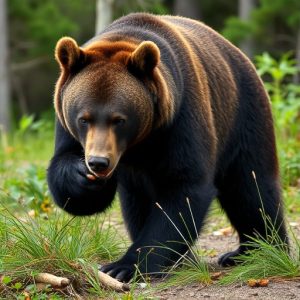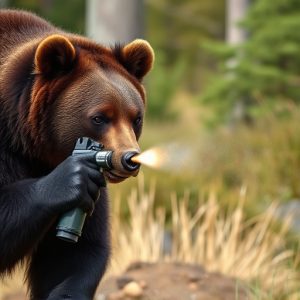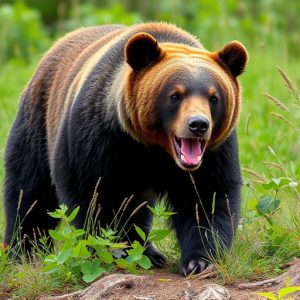Maximizing Alaska Bear Repellent Range: A Comprehensive Guide
Bear spray, a key defense against aggressive bears in Alaska's wilderness, utilizes capsaicin (…….
Bear spray, a key defense against aggressive bears in Alaska's wilderness, utilizes capsaicin (chili pepper derivatives), oleoresin capsicum, and synthetic/natural pyrethrins. These chemicals disrupt a bear's senses, encouraging flight. Understanding active ingredients like capsaicin, their functions, and the spray's maximum range (20-30 feet) is crucial for maximizing effectiveness. Choosing the right bear repellent with specific chemicals, such as capsaicin and THK, and considering range & nozzle type ensures safety in bear country. Proper application techniques, testing, and renewals enhance safety during outdoor activities.
“Alaska’s vast wilderness is home to powerful bears, making bear repellent an indispensable tool for outdoor enthusiasts and hunters. This comprehensive guide explores the science behind these vital protection devices. We delve into the maximum range of bear spray, examining factors like weather conditions and terrain that influence its effectiveness. Additionally, we provide insights on choosing the right spray, considering active ingredients like capsaicin and pepper, and offer application techniques to ensure optimal safety in bear country.”
- Understanding Bear Spray: A Vital Tool for Alaska's Wilderness
- The Science Behind Bear Repellents: Active Ingredients Explained
- Maximum Range: Factors Affecting Effectiveness of Bear Spray
- Choosing the Right Bear Spray: Considerations for Alaska Hunters and Outdoor Enthusiasts
- Application Techniques: Maximizing Protection in Bear Country
Understanding Bear Spray: A Vital Tool for Alaska's Wilderness
Bear spray, also known as bear repellent, is a vital tool for anyone venturing into Alaska’s wilderness. It’s designed to deter aggressive bears when used correctly, providing a critical layer of protection for outdoor enthusiasts and residents alike. The effectiveness of bear spray lies in its active ingredients, which are chemical compounds specifically formulated to disrupt a bear’s sense of smell and sight, causing it to flee the area.
The most common chemicals found in bear spray include capsaicin, oleoresin capsicum (a derivative of chili peppers), and various synthetic or natural pyrethrins. These substances are potent irritants for bears, mimicking the effect of a strong, unpleasant smell that can signal danger. Understanding what’s in your bear spray and how it works is key to ensuring its maximum effectiveness when you find yourself face-to-face with a wild bear.
The Science Behind Bear Repellents: Active Ingredients Explained
Bear repellents, particularly bear spray, have evolved over time, and their effectiveness relies on understanding the science behind their active ingredients. These repellents contain specific chemicals designed to deter bears by creating an unpleasant sensory experience. The key to their success lies in these active compounds that can repel bears from a certain distance, known as the maximum range.
Commonly used chemicals in bear spray include capsaicin, a compound found in chili peppers, and synthetic urine. Capsaicin stimulates the bear’s eyes, nose, and respiratory tract, causing them to associate the scent with discomfort and potentially danger. Synthetic urine mimics the scent of a potential predator or a territorial threat, encouraging bears to avoid the area. These ingredients work together to create an effective barrier, ensuring outdoor enthusiasts can enjoy their activities in bear country while minimizing conflict with these majestic animals.
Maximum Range: Factors Affecting Effectiveness of Bear Spray
The maximum range of a bear repellent, like bear spray, is influenced by several factors. One of the primary considerations is the active ingredients in the spray. Bear sprays typically contain chemicals designed to deter bears through irritation or taste. Common agents include capsaicin (from chili peppers), pyrethrins (derived from chrysanthemums), and oleoresin capsicum (a potent component of chili peppers). These chemicals play a crucial role in the spray’s effectiveness, as they target the bear’s sensory systems.
Other factors affecting range include weather conditions, terrain, and the bear’s behavior. For instance, wind direction and speed can significantly impact the reach and accuracy of the spray. Rough or uneven terrain might also limit the spray’s projection. Additionally, the type of bear, its size, and its previous exposure to repellents can influence how it reacts to the spray within a given range. Understanding these variables is essential for users to gauge the optimal distance for application in various scenarios.
Choosing the Right Bear Spray: Considerations for Alaska Hunters and Outdoor Enthusiasts
Choosing the right bear repellent, particularly bear spray, is paramount for Alaska hunters and outdoor enthusiasts. When selecting a product, pay close attention to its active ingredients. Common chemicals in bear spray include capsaicin, which is derived from chili peppers, and tetrahydrokanin (THK), a synthetic version of a compound found in bee venom. These components are effective in deterring bears by causing temporary yet intense irritation.
Additionally, consider factors like the spray’s range—typically measured in feet—and nozzle type. A longer range allows for more distance between you and potential bear threats, while a wide-angle nozzle can cover a broader area. Always check product labels and user reviews to understand the specific chemicals, their potency, and the performance characteristics of the bear spray before venturing into Alaska’s wilderness.
Application Techniques: Maximizing Protection in Bear Country
In bear country, knowing how and when to apply bear repellent is crucial for maximizing protection. One of the most common methods is using bear spray, a potent chemical deterrent designed to deter aggressive bears. Understanding what chemicals are in bear spray is essential; these include capsaicin, a compound derived from chili peppers, and other irritants that cause a stinging sensation and temporary blindness. When applying bear spray, aim for the bear’s face and eyes, as this will ensure maximum impact. The recommended range for effective use is around 20-30 feet (6-9 meters), allowing for quick deployment when encountering a bear.
To make the most of your bear repellent, practice application techniques before venturing into bear country. Familiarize yourself with the spray’s range and pressure settings. Bear sprays are designed to be used in close proximity to the bear, so ensure you follow safety guidelines and never point it at other people or pets unless absolutely necessary. Regularly testing and renewing the spray’s effectiveness is also vital, as chemicals can degrade over time. By combining proper application techniques with regular maintenance, individuals can significantly enhance their safety when hiking or camping in areas inhabited by bears.
Bear spray is a powerful tool for protecting oneself in Alaska’s wilderness, but understanding its maximum range and effective application techniques is crucial. By knowing the science behind bear repellent chemicals, such as capsaicin and pepper, and considering factors like wind and distance, users can ensure optimal protection during outdoor activities. Choosing the right spray that suits individual needs and practicing proper application techniques can make a significant difference in safety while navigating Alaska’s beautiful but potentially dangerous landscapes.


